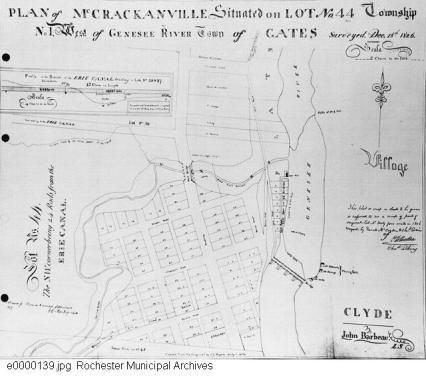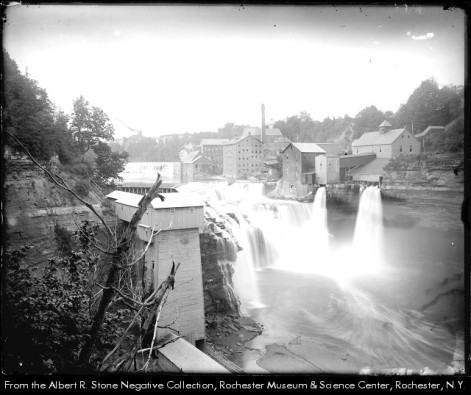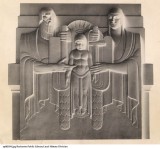In earlier posts, we heard of communities that had a formal independent existence, but which failed to displace Rochester and were eventually absorbed by the larger community: Carthage; Castletown; Dublin; and King’s (later Hanford’s) Landing. All these communities left something behind to testify to their existence. Castletown and King’s Landing left their cemeteries. Carthage and Dublin left street names.
For the subject of this profile, McCrackenville, however, nothing remains, not even a name. Even the bridge, which is the last tangible reminder, has been renamed. No longer is it the McCracken Street Bridge; today it is the Driving Park Bridge. Not even the people who live along that portion of Lake Avenue are aware that they live in what was once McCrackenville.
In its day, McCrackenville was a thriving manufacturing center running along Lake Avenue from the Middle Falls (Ravine Avenue) to the Lower Falls (Driving Park Bridge), much of it at the level of the river. The community was named for David McCracken (28 February 1768-16 July 1842), who was a physician by trade. His large stately home was located at what is today the southwest corner of Lake Avenue and Driving Park (where the Convenience R Us store is). Dr. McCracken arrived in the area about 1815, accompanied by his brothers William McCracken (1783?-6 June 1872) and Gardner McCracken (1786?-30 April 1845).

Map of McCrackenville (1826)
William McCracken built and ran the North American Hotel, on State Street between Brown and Busch Streets, in what was then the community of Frankfort. His brother Gardner owned a flour mill along Lake Avenue, later moving his home across Lake Avenue from his brother David. These prosaic occupations (physician, tavern owner and miller) disguised an ambition as landowners and developers.
Between 1821 (when the first Monroe County deed and property book begins) and 1855, the three brothers bought 36 properties along what is now Lake Avenue south of Driving Park Avenue (at the time part of the town of Gates). This does not represent the full extent of their holdings as other property was purchased before Monroe County was founded (i.e., when the area was still part of Genesee and Ontario Counties). This can be demonstrated by the fact that within this same 34-year time period, the brothers sold 86 parcels to other people.
Of the brothers, David McCracken was the person who sold off the largest number of lots for development, 47. That was twice as much as Gardner and William, who sold 22 and 17, respectively. The purchasers of the parcels were generally businessmen who established their own factories. The two industries of longest duration at McCrackenville were paper milling and furniture manufacturing. One of the oldest businesses was P. Foley and Company (a paper manufacturer), which was succeeded by Stoddard and Freeman in 1851. The area also included a tannery for making leather.
For the brothers, it was not enough to sell off the properties; they wanted the area developed. We know this from a letter Gardner McCracken wrote to the Mayor and Common Council of Rochester in 1841 complaining of the neglect of highways on the west side of the river, advocating for a “turnpike” between the city and the harbor at the lake. The road was eventually built, but not in his lifetime, as Gardner died four years later.
The city annexed McCrackenville in 1850 and slowly developed the area for residential, rather than industrial, property. The last industrial site to go the way of the wrecking ball was the original tannery site, which was succeeded by furniture manufacturing plants. The site was razed in the mid-1960s.

McCrackenville (ca 1906-1910)
-Christopher Brennan
